Serbian Medieval History
Byzantine Coinage
 By Radmilo Bozinovic
By Radmilo Bozinovic
Since their first arrival on the Balkan peninsula early in the 6th c. and definite emergence on the historical scene, the South Slavs had their history and destiny inextricably tied with the Constantinopolitan state. Indeed, Balkan history throughout the medieval era (between late antiquity and the Ottoman invasion) closely parallels that of the Byzantine empire, which at different times acted as a mentor, ally, and foe of the Balkan Slav nations.
As such, the Serb history of this period can not be understood without accounting for this complex relationship, and the powerful Greek state on the other end of it. The brief historical commentary provided with the exhibits is obviously not intended to be comprehensive in any way; rather, it is meant to highlight certain interesting facts, in particular some of those pertaining to the interactions and coexistence of South Slavic and Hellenic peoples and states in the Balkans during the Middle Ages.
While the beauty and richness of the ancient Greek and early Roman coinage remain unsurpassed, the Byzantine series, with both the stability and variety exhibited during its thousand-year span, remains unique in the history of numismatics. Throughout this period, Byzantine coins came in three basic metal types: gold, silver, and bronze. Featured here are mostly bronze coins, which were the bulk of circulating money.
The transition point between the (Eastern) Roman and Byzantine empires - typically placed somewhere between the 4th and 7th centuries - is largely a matter of historical convenience, since the Empire itself knew no such distinction. The usual numismatic convention is to begin the Byzantine period of coinage with the great monetary reform of Anastasius I, in 498 AD. Here, our exhibits start with issues of Constantine I, in part since foundations for two basic tenets of the Byzantine Empire - a Greek tradition and Christian religion - were largely laid down by Constantine the Great himself.
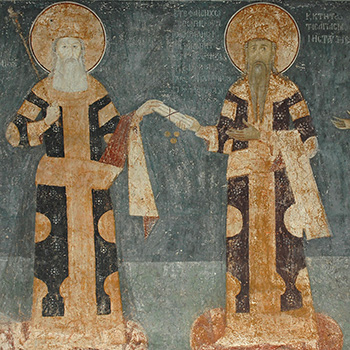 Ties symbolized: King Milutin of Serbia presenting the charter of the Hilandar (Chilandari) monastery on Mt. Athos to his father-in-law, Byzantine Emperor Andronikos II, 1320
Ties symbolized: King Milutin of Serbia presenting the charter of the Hilandar (Chilandari) monastery on Mt. Athos to his father-in-law, Byzantine Emperor Andronikos II, 1320
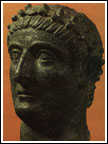 CONSTANTINE I, THE GREAT (307-337 A.D.)
CONSTANTINE I, THE GREAT (307-337 A.D.)
FOLLIS
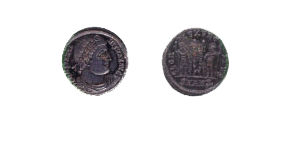
| Obv.: | Bust of Constantine, legend: CONSTANTINVS MAX AVG ("Constantine the Great Emperor") |
| Rev.: | Two Roman soldiers standing next to two standards, legend: GLORIA EXERCITVS ("Glory to the Army") |
SMALL BRONZE (COMMEMORATING DEDICATION OF CONSTANTINOPLE)
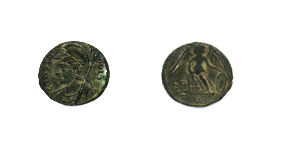
| Obv.: | Helmeted bust of the personification of Constantinople, legend: CONSTANTINOPOLIS |
| Rev.: | Victory standing with a foot on the prow of a ship, holding a scepter and shield |
POSTHUMOUS SMALL BRONZE
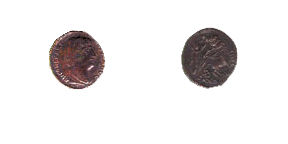
| Obv.: | Draped bust of Constantine, legend: DIVO CONSTANTINO ("to the Divine Constantine") |
| Rev.: | Constantine driving a chariot of four horses (quadriga), following God's hand in the sky |
| HISTORICAL NOTES: A great statesman whose accomplishments had long-lasting repercussions. His personal conversion coincided with the transformation of Christianity to a state religion, starting with the Edict of Milan proclaiming religious tolerance in 313 A.D. The dedication of Constantinople as the imperial capital in 330 paved the way for its ascendance in the following centuries. The legend of Constantine, who was born in Naissus (near present-day Nis in Serbia), was partially preserved in Serb tradition. For example, while in no way based in fact, the legendary Nemanjic royal lineage - described in some medieval Serbian chronicles as beginning with Constantine's father Constantius I - attests to the depth of his popular memory. |
NUMISMATIC NOTES: Along with many other reforms, Constantine implemented a sweeping monetary restructuring that was to reflect economic and inflationary changes. The main precious metal coin became the solidus, weighing ca. 4.5 g (1/72nd lb.) of gold - the flagship Byzantine denomination for many centuries hence (and from which the much later solde of Dubrovnik were to derive their name). One solidus equaled a fixed 24 silver silique, which were originally measured based on the 1:18 gold/silver ratio, but later fluctuated with bullion value, thus resisting inflation. Late in Constantine's reign and during that of his sons, pagan themes (e.g. Zeus/Jupiter) started getting replaced first by neutral, and finally by Christian ones. |
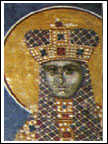
ST. HELENA (died 330)
SMALL BRONZE
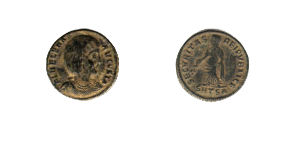
| Obv.: | Bust of Helena, legend: FL HELENA AVGVSTA ("Flavia Helena, Empress") |
| Rev.: | A personification of security standing holding branch, the legend: SECVRITAS REIPVBLICAE, mint mark: SMTSA |
| HISTORICAL NOTES: Helena was the wife of emperor Constantius I Chlorus, and mother of Constantine the Great. Constantine and Helena's great religious deeds in the Holy Land (including her discovery of the True Cross) have earned them admiration among the Church and believers, leading eventually to their canonization. The pair's frequent image on Orthodox frescoes and icons is that of medieval imperial rulers rather than of the ancient Romans they were, as shown on their lifetime coin portraits. |
NUMISMATIC NOTES: Numerous money mints operated in the Roman Empire, and they can be readily identified for the coinage of the Constantinian dynasty. The mint-mark inscription is usually found at the bottom of the reverse side, and in this case, the letters "SMTSA" are to be interpreted as follows: "SM" for "Sacra Moneta" - a mint-independent declaration of the money's validity; "TS" for Thessalonika (northern Greece); "A" for the first "officina", or workshop, within the mint. In fact, several new mints opened during this time, including a large one in Sirmium - next to present-day Sremska Mitrovica in northern Serbia. |
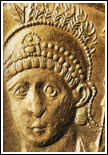 CONSTANTIUS II (337-361)
CONSTANTIUS II (337-361)
SMALL BRONZE
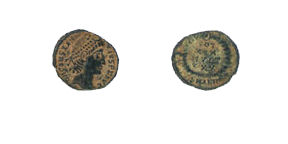
| Obv.: | Bust of Constantius, legend: DN CONSTANTIVS PF AVG ("Our lord Constantius, dutiful and wise Emperor") |
| Rev.: | Votive inscription (VOT XX MVLT XXX) in wreath |
| HISTORICAL NOTES: Constantius continued most of his father's policies, further strengthening the role of Christianity in state affairs. He also briefly reunited the Empire that had been again split after his father's death, but difficulties in governing it led him to split it once more, concentrating his efforts in the East. |
NUMISMATIC NOTES: The 355 A.D. adjustment of the precious metal monetary system reflected relative changes in bullion value (gold/silver ratio now being 1:12), but still left the exchange rate to further fluctuate with intrinsic value, leading to a stable and varied silver currency. An earlier attempt at reforming bronze coinage was, however, less successful. The relatively high quality of coin portrait engraving evidenced here will soon start to disappear, not to reemerge for many centuries hence. |
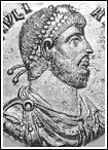
JULIAN II, THE APOSTATE (355-363
SMALL BRONZE
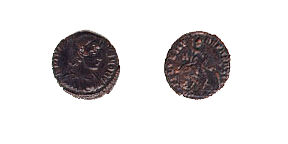
| Obv.: | Bust of Julian, legend: IMP IVLIANVS NOB CAES |
| Rev.: | Roman soldier spearing fallen enemy horseman, the legend: FEL TEMP REPARATIO ("Return of the felicitous times") |
| HISTORICAL NOTES: An educated, capable, and popular ruler. However, his attempt to revive pagan worship and institutions was short-lived, as it failed soon following his death in an ambush during the campaign against the Persians. |
NUMISMATIC NOTES: Julian's last gasp of paganism was reflected in his coinage as well. His later issues (as evident from the given portrait) showed him as a bearded "philosopher-emperor", with reverse sides reviving images of the rediscovered Apis bull cult - the last pagan theme to appear on Roman coinage. Incidentally, these large pieces were also a failed attempt to restore the confidence in bronze coinage, which was soon to slide into unimportance - a state that would change only with the radical monetary reform of Anastasius, well over 100 years later. |

THEODOSIUS I, THE GREAT (379-395)
LARGE BRONZE
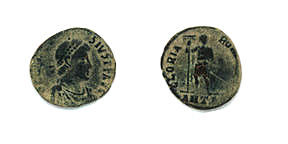
LARGE BRONZE
| Obv.: | Bust of Theodosius, legend: DN THEODOSIVS PF AVG ("Our lord Theodosius, the dutiful and wise emperor") |
| Rev.: | Emperor standing, holding labarum and globe, the legend: GLORIA ROMANORVM ("Glory to the Romans") |
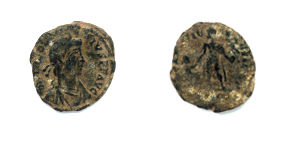
| Obv.: | Bust of Theodosius, legend: DN THEODOSIVS PF AVG ("Our lord Theodosius, the dutiful and wise emperor") |
| Rev.: | Emperor standing, holding Victory and raising kneeling woman, the legend: REPARATIO REIPVB ("Restoration of the Republic") |
| HISTORICAL NOTES: Following Theodosius' abolition of the Olympic games (391) and other pagan relics, and his defeat of the last protagonist of a pagan revival, Eugenius (394) - Christianity gets entrenched for good, with various heresies like Arianism dismissed. The serious Gothic threat was evaded in the East through smooth diplomacy that allowed to gradually incorporate them - though at a price - into the state system. The Empire was strengthened and briefly reunited - only to get finally divided after his death into the East and West, originally ruled by his two sons, Arcadius and Honorius, respectively. |
NUMISMATIC NOTES: Until the age of mass communication, coinage served, apart from its monetary role, as a unique opportunity for central governments to disseminate public messages and propaganda. While adherence to strict religious themes makes later Byzantine issues more subtle in this respect, reverse types of this era were often directly used for this purpose. Theodosius' progressive civil legislation gets advertised here with a claim to a "restoration" of the Republic (and presumably its values), with the suggestive scene of the Emperor |
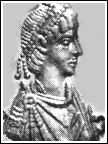
LEO I (457-474)
SMALL BRONZE (NUMMUS)
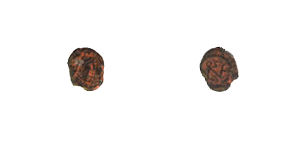
| Obv.: | Bust of Leo, legend: DN LEO ("Our lord Leo") |
| Rev.: | Monogram of Leo |
| HISTORICAL NOTES: At first virtually a puppet ruler of Germanic generals, Leo employed the Eastern tribe of Isaurians to neutralize them - in a move that was to become typical of Byzantine political prowess. Thus, as the Western Empire disintegrated, the East embarked on an often thorny, but the millennial road of prosperity. |
NUMISMATIC NOTES: The feudalization of society and other economic changes decreased the importance for non-precious metal (bronze or copper) coinage, while that of gold remained - if mainly for paying mercenaries and bribing barbarian chieftains. This is evidenced by the ever-increasing crudeness of execution, reduction in size, the disappearance of any silver content, and lack of fractional denominations - all prevalent by Leo's reign. Despite that, a new design was introduced around this time - the name-encoding monogram. Often used by ancient Greeks to denote magistrates and mint officials, it will occasionally appear on Byzantine coinage for the next 700 years. |
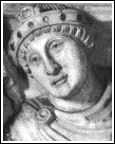
ANASTASIUS I (491-518)
REFORMED FOLLIS OF ANTIOCH
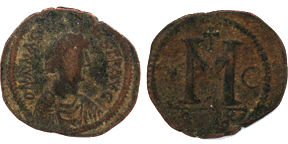
| Obv.: | Bust of Anastasius, Latin legend: D N ANASTASIVS PP AVG ("Our lord Anastasius, the eternal Emperor") |
| Rev.: | New standard design with a denomination, etc. |
| HISTORICAL NOTES: A wealthy tax official from Illyricum (present-day Yugoslavia) when chosen by the imperial widow to succeed the throne, Anastasius enriched the state treasury through wise fiscal policies, preparing the ground for the achievements of Justinian. Among other things, he executed an important monetary reform with long-lasting results. The first recorded incursion of South Slavs into the Balkans takes place in 517. Shortly before that, the Asiatic warrior tribe of Bulgars makes its first appearance in the peninsula - later, they were to settle and subdue the west Balkan Slavic population, but by the late 9th c. they will end up being Slavicized themselves. The subsequent medieval Balkan history largely revolves in the triangle of the emerging Bulgar and Serb states and regional Byzantine interests. |
NUMISMATIC NOTES: The reform of 498 introduced different bronze denominations, as multiples of a basic unit, nummus. The system was: 40 nummi = 1 follis, 140 folles = 1 gold solidus, etc. Standard elements were introduced in the reverse design of bronze coinage: Greek numerals (letters used as numbers) denoted denominations (in nummi) for more than three following centuries (e.g., M=40, K=20, I=10); a 2-6 letter Latin inscription marked the mint (e.g. CON, NIKO, THEUPO); a small Greek letter indicated the mint office; and later, a Roman numeral date showed the ruler's regnal year. |
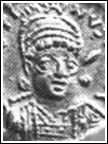
JUSTIN I (518-527)
HALF FOLLIS (20 NUMMI) OF NICOMEDIA
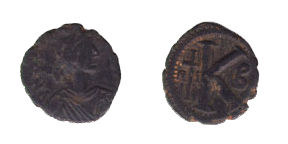
| Obv.: | Bust of Justin, legend: DN IVSTINVS PP AVG |
| Rev.: | Cross, denomination (K = 20), mint (NI = Nicomedia), mint office B |
5 NUMMI
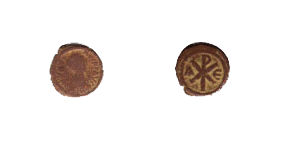
| Obv.: | Bust of Justin legend: DN IVSTINVS PP AVG |
| Rev.: | Denomination (E = 5), mint office, and Christogram |
| HISTORICAL NOTES: A rough military commander from Macedonia, Justin helped usher in the age of his famous nephew Justinian. The reestablishment of religious orthodoxy and improved relations with the Roman Church laid foundations for the later reconquest of Italy and other accomplishments. |
NUMISMATIC NOTES: The reverse design - the monogram of Greek letters "chi" and "ro", known as a Christogram - is by legend, the sign that Christ told Constantine the Great in his dream to put on banners before the next day's big battle against rival Maxentius in 312, which he won. |
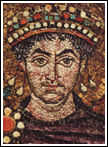
JUSTINIAN I, THE GREAT (527-565)
FOLLIS OF THEUPOLIS (ANTIOCH)
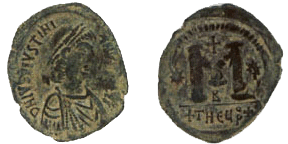
| Obv.: | Diademaed and draped Justinian's profile bust, the legend: DN IVSTINIANVS PP AVG |
| Rev.: | Denomination |
LATER FOLLIS OF THEUPOLIS
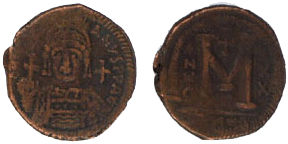
| Obv.: | Helmeted and cuirassed Justinian's facing bust, holding globus cruciger (globe with a cross) legend: DN IVSTINIANVS PP AVG |
| Rev.: | Denomination |
HALF FOLLIS OF THEUPOLIS
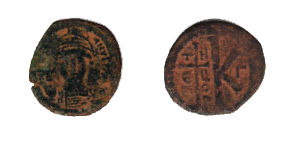
| Obv.: | Helmeted and cuirassed Justinian's facing bust, legend: DN IVSTINIANVS PP AVG |
| Rev.: | Denomination |
| HISTORICAL NOTES: In many ways, The Byzantine Golden Age. Among other things, it saw the temporary reintegration of the Empire all around the Mediterranean, the glorious Church of Hagia Sophia (Holy Wisdom) built in Constantinople, and a famous legal codex published. However, the territorial expansion came at a great cost and was soon to unravel. Meanwhile, Slavic incursions become much bolder, taking advantage of Justinian's focus on the Goths in Italy. "[Slavs] constantly approach and quietly attack those who pass there, making these places insecure," wrote the famous chronicler Procopius of some areas south of the Danube. A whole system of makeshift fortifications was built but fared poorly against the Slavs, Bulgars, and the new threat - the Asiatic Avars. |
NUMISMATIC NOTES: Relative dating of coins gets reintroduced: following a tradition from an earlier Roman period, starting with 538 AD, coins were dated, with Roman numerals, to represent the regnal year of the current emperor; thus, "XII" denotes the twelfth year of Justinian's reign, (538/9 AD). This system persisted on bronze coins for nearly 200 years to follow. The image of a facing Emperor with various Christian insignia starts to replace the classical Roman profile, and will soon become the characteristic representation of the whole Byzantine series - eventually influencing other issues of medieval coinage, including those of the Balkan Slav states of Serbia and Bulgaria. |
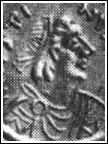
JUSTIN II (565-578)
FOLLIS OF THEUPOLIS
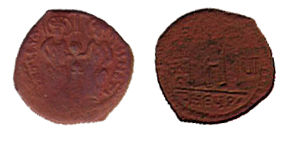
FOLLIS OF CONSTANTINOPLE
| Obv.: | Ruling couple enthroned, holding globe and scepters |
| Rev.: | Denomination |
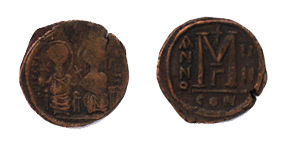
HALF FOLLIS OF THESSALONIKI
| Obv.: | Ruling couple enthroned, holding globe and scepters |
| Rev.: | Denomination |
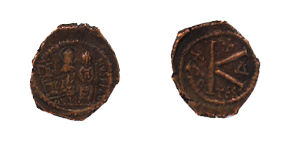
| Obv.: | Ruling couple enthroned, holding globe and scepters |
| Rev.: | Denomination |
| HISTORICAL NOTES: Justin was largely unfit for the daunting task of keeping together his uncle's ambitious achievements; his wife Sophia (featured prominently on coins) exerted considerable influence. Slavs reach the Peloponnese in 578 and begin to gradually settle in the Balkans. |
NUMISMATIC NOTES: Numismatic evidence can occasionally shed important light on historic events. In this case, a series of recently discovered hoards (hidden coin deposits) revealed a trail that implied a hitherto unknown incursion of Slavs over the Danube into the Byzantine Balkans, all the way to Thessaloniki and Thasos (northern Aegean), around 571. Iconographically, the image of two enthroned or standing facing figures (ruling pair or ruler and saint) will make a sustained appearance on Byzantine and other Mediterranean coinages for another 800 years, starting around this time. |
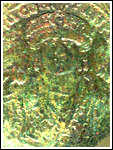
MAURICE TIBERIUS (582-602)
FOLLIS OF THEUPOLIS
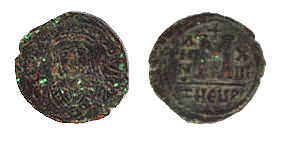
| Obv.: | Crowned bust of Maurice in consular robes, holding scrolls and eagle-tipped scepter, the legend: DN MAVR PP AVG |
| Rev.: | Denomination |
| HISTORICAL NOTES: A remarkable general and statesman, with notable successes both in the West and East (Persia), but failures in the Balkans against South Slav penetrations ultimately led to his overthrow and murder. While still based on the left (north) side of the Danube, the Slavs "begin to stay over winter and feel like in their own land", as wrote John of Ephesus in his chronicle from 584. Their intense siege of Thessaloniki in 586 was miraculously repelled - as legend holds it, only after the city protector, St. Demetrius, finally intervened. |
NUMISMATIC NOTES: As a result of the massive Slavic and Avar invasions and the ensuing effective disintegration of Byzantine authority in Illyricum (roughly, present-day Serbia), after the time of Maurice, Byzantine coinage is no longer to be found in these areas until the mid-10th c. His issues are still rather plentiful (including some recently discovered new types from Justinian's birthplace, Iustiniana Prima or Caricin Grad, in southeastern Serbia), but by now, the numerous coin hoards appear to be found only inside city walls - indicating times of great uncertainty. |
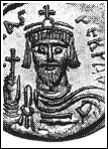
PHOKAS (602-610)
DEKANUMMIUM (10 NUMMI) OF CATANIA
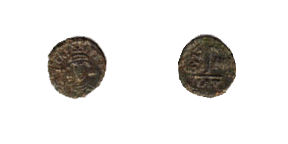
| Obv.: | Bust of Phokas, legend: DN PHOCAS PP AVG |
| Rev.: | Denomination |
| HISTORICAL NOTES: A rather short and overall disastrous reign, eventually to be ended by the revolt of Heraclius. Persians advanced in the East, and in the Balkans, active resistance to Slav and Avar advances was mostly abandoned, as the Danube-Sava frontier effectively collapsed. The end to Phokas' anarchy also marks an end of the initial period of the Byzantine state, burdened as it was with many ineffective Roman legacies. In the words of one of the greatest Byzantinists, the late Prof. Ostrogorsky of the Belgrade University, "only now begins Byzantine history in the true sense, history of the medieval Greek empire." |
NUMISMATIC NOTES: In a theme we have seen recurring throughout the late 6th century, the numismatic evidence - given sparse documentary data - plays a major role in assessing the Slavic penetration into the Balkan peninsula. For instance, the last pre-9th c. coins found at Olympia (site of the ancient Olympics) in western Peloponnesus are those of Phokas - suggesting the time and duration of the Slavic settlement and occupation of this southernmost part of the Balkans. |
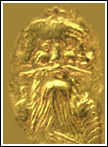
HERACLIUS (610-641)
FOLLIS OF KYZIKOS
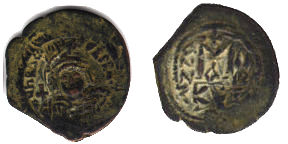
| Obv.: | Bust of Heraclius, legend: hRACLI PERP AVG ("Heraclius, the eternal Emperor") |
| Rev.: | Denomination |
FOLLIS OF CONSTANTINOPLE
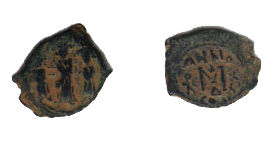
| Obv.: | Imperial family standing |
| Rev.: | Cross, denomination (M = 40), mint (CON = Constantinople), mint office "delta", regnal year (ANNO XIII = 13), monogram of mint official |
DODEKANUMMIA (12 NUMMI) OF ALEXANDRIA
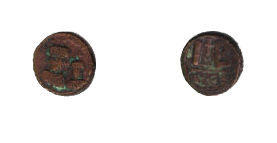
| Obv.: | Heraclius and son Heraclius Constantine |
| Rev.: | Denomination (IB = 12) |
HALF FOLLIS OF SICILY
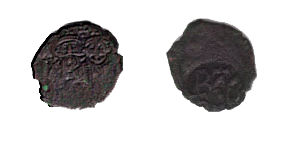
| Obv.: | Heraclius and son Heraclius Constantine |
| Rev.: | Countermark of Sicily |
FOLLIS OF KYZIKOS
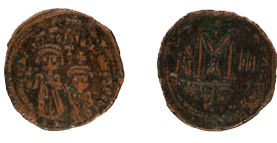
| Obv.: | Heraclius and son Heraclius Constantine |
| Rev.: | Denomination |
| HISTORICAL NOTES: One of the greatest dynasty-founding Byzantine rulers. Wise internal reforms had long-lasting positive consequences, and his Eastern heritage further helped the state shake off the Roman veneer in favor of its Greek roots. To this day a pre-Easter Greek Orthodox holiday commemorates the vigil that was believed to have helped break the siege of Constantinople in 626 and spearheaded Heraclius' subsequent victories against the Avars and Persians. His protracted and brilliant campaign against the latter led to the triumphant recovery of important Christian relics including the True Cross, and to the effective destruction of pre-Islamic Sassanid Persia. Yet, toward the end of his reign, the new Arab threat ominously emerges in the East. Balkan affairs were secondary at the time, and Serbian settlements in the Western provinces were allowed to remain. |
NUMISMATIC NOTES: Bronze coinage flourished during Heraclius' time, as evidenced by a multitude of types. Occasionally, even odd denominations were struck, like 33 nummi, or the 12 nummi of Alexandria (Egypt) shown here. Differences in styles can also be noticed, e.g. by comparing the cruder style of the Kyzikos (Western Asia Minor) folles and those of Sicily. |
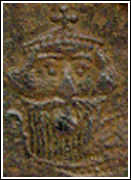
CONSTANS II (642-668)
FOLLIS OF SICILY
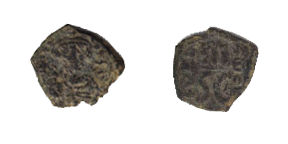
| Obv.: | Bust of Constans |
| Rev.: | Denomination |
FOLLIS OF CONSTANTINOPLE
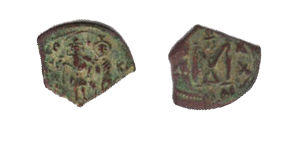
| Obv.: | Constans and son Constantine IV standing |
| Rev.: | Denomination |
| HISTORICAL NOTES: While Arab advances claimed the rich province of Egypt permanently in 642, Constans managed to strengthen the Empire elsewhere. His campaign against the South Slavs in 658 ended in success and resulted in large numbers of them being transported to Asia Minor, to serve in the imperial army. Over a century and a half later, Thomas the Slav - a descendant of these settlers that rose to be a general - headed a failed social revolt that was to seriously threaten and shake the Empire. |
NUMISMATIC NOTES: Many medieval coins - precious and base metals alike - were later "clipped", to reuse portions of the metal, as evidenced here. |
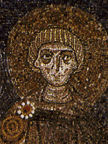
CONSTANTINE IV POGONATOS (668-685)
DEKANUMMIUM (10 NUMMI)
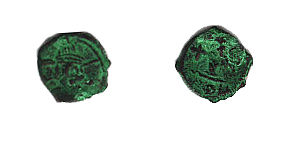
| Obv.: | Bust of Constantine, holding spear |
| Rev.: | Denomination |
| HISTORICAL NOTES: Co-emperor for fourteen years prior to his father's death, Constantine victoriously endured a great Arab siege of the capital during 674-8 (aided by solid city walls, but also by effects of the famous "Greek fire" - a precursor to firearms - on enemy ships) - in what was the first and most important turning of the tide for the Arab wave. In the meantime, larger-scale Bulgarian migrations under khan Asparuch from the Caucasus down to the Danube delta and the northeast Balkans could not be checked, as they caused the creation of the first Bulgaro-Slavic state recognized by the Empire. |
NUMISMATIC NOTES: Constantine's image with a spear and shield temporarily revived a motive common on Roman gold pieces 200 years earlier, and probably reflects the daunting military tasks facing him. He also tried to revive the quality of bronze coinage, but this reform ended up being short-lived. |
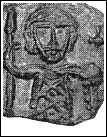
LEO III, THE ISAURIAN (717-741)
FOLLIS OF SYRACUSE
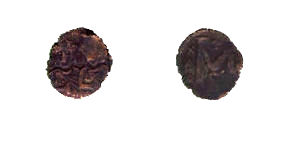
| Obv.: | Leo and son Constantine V |
| Rev.: | Denomination |
| HISTORICAL NOTES: Leo, the founder of the Isaurian dynasty, broke another grand siege of Constantinople by the Arabs, then further pursued them, relying on alliances with Bulgars and Khazars. Along with similar achievements by Constantine IV some decades earlier, these victories defined, even more so than the later Battle of Poitier, an end to Muslim Arab expansion and deliverance for Europe. However, Leo also introduced the infamous iconoclast controversy - a doctrinally debate over the veneration of icons - which would haunt many levels of public life for more than a century. In the Balkans, relations are illustrated by a barely broken two-year siege of Thessaloniki by Slavs loyal to local prince Prebud (735). More generally, Leo's decision to subject most of the Balkans to the Patriarch of Constantinople rather than to that of Rome was later to have profound cultural and political consequences. |
NUMISMATIC NOTES: While already for a long time far less artistic than during the times of Constantine the Great and his successors, coin portraits become now even further stylized - a state that will last for about another 200 years. By Leo's time, the bronze follis is considerably reduced in size, numerous mints disappear (e.g. Theupolis, Kyzikos, Thessaloniki), leaving only the one in the capital - mostly serving the Greek urban and coastal areas - and another one in Syracuse (Sicily), serving the Italian markets. |
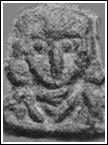
CONSTANTINE V, KOPRONIMOS (741-775)
FOLLIS
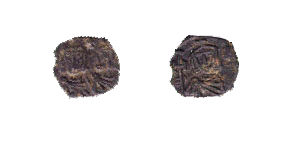
| Obv.: | Constantine and son Leo IV |
| Rev.: | Constantine's father, Leo III, holding a long cross |
| HISTORICAL NOTES: Much like his father Leo III, Constantine was a great commander, but also a great iconoclast. This created considerable internal turmoil and had cost the Empire some possessions and influence in Italy. Still, Constantine did achieve great military successes against both the Arabs and Bulgars (763). The latter led to a relocation to Asia Minor of some 200,000 Slavs allied with Bulgaria, but also to their increased piracy in the Aegean Sea. |
NUMISMATIC NOTES: Occasionally, Byzantine rulers honored their parents on coinage, as did Constantine here with his great father. This coin also denotes a departure from the centuries-old denomination-based reverse design. |
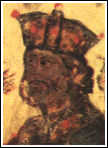
NIKEPHOROS I (802-811)
FOLLIS
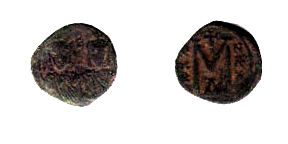
| Obv.: | Nikephoros and son Stavrakios |
| Rev.: | Denomination |
| HISTORICAL NOTES: During this reign, the emerging Frankish expansion under Charlemagne and his many allies was the main threat, following the latter's threatening coronation as Western emperor in 800 (his name eventually rooting the Slavic word for "king"). Nikephoros was successful in fighting the Arabs, and Slavs were expelled from the Peloponnese after more than two centuries. However, the struggle against Bulgars under khan Krum showed just how shifting can military fortunes sometimes be: after a splendid victory that sacked their capital Pliska, he unwisely pursued them into the mountains where the Byzantine army was ambushed and routed, and Nikephoros himself (his name ironically meaning "victory carrier") captured and killed. |
NUMISMATIC NOTES: The decline of bronze coinage further continues, as money from this era becomes rather scarce (indicating reduced mint output), and fractional denominations largely disappear. |
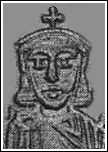
LEO V, THE ARMENIAN (813-820)
FOLLIS OF SYRACUSE
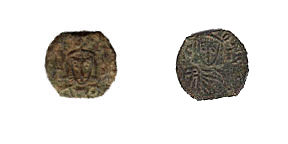
| Obv.: | Bust of Leo, legend: LEO |
| Rev.: | Leo's son Constantine, legend: KONCT |
FOLLIS OF SYRACUSE
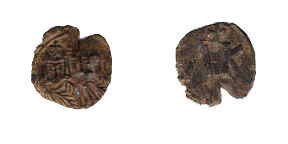
| Obv.: | Leo and his son Constantine |
| Rev.: | Greek letters "lambda" and "kappa" (ruler initials), cross between them |
| HISTORICAL NOTES: Formerly a strategos (general) from the eastern province of Anatolia, Leo achieved some success against the Bulgars, particularly after Krum's sudden death during the siege of Constantinople in 814. Internally, he pursued the rather unpopular by now iconoclast policy, which finally led to his assassination, right in the church of St. Sophia, by followers of his former comrade-in-arms, Michael the Amorian. |
NUMISMATIC NOTES: The combination of costumes shown here on the first coin for Leo and his successor is indicative of a duality that evidenced in coinage for some three hundred years, starting with the late 7th c. The Emperor is shown in a loros - one of the quintessential imperial insignia for the later Byzantine period, which would eventually be copied in the Bulgarian and Serbian royal attire. His son Constantine, however, is pictured in a chlamys - an imperial garment (mantle fastened at the shoulder) more readily associated with the classical Roman period. |
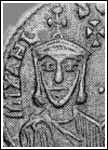
MICHAEL II, THE AMORIAN (820-829)
FOLLIS OF SYRACUSE
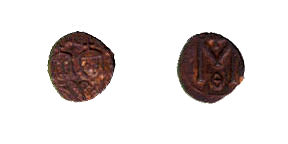
| Obv.: | Michael and son Theophilos, legend: MIXAHL S OEOF |
| Rev.: | Denomination, cross above and Greek initial "theta" below |
| HISTORICAL NOTES: According to 10th c. emperor-historian Constantine Porphyrogenitos, the 9th century in the Balkans witnessed increased defiance by Serbs and Croats, "particularly during the rule of Michael the Amorian". This was probably caused by aggressive Bulgar expansion, which revealed the apparent Byzantine weakness, but most of all posed a direct threat. This time the Serbs under prince Vlastimir - their unity sparked by the imminent danger and aided by some Byzantine diplomacy and gold - repelled Bulgar attacks around 845, forging their first known state in the process. |
NUMISMATIC NOTES: Michael attempted a reform of the long-neglected bronze coinage - a task that was only to be completed by his son Theophilos, with results basically persisting for over 250 years, until the late-11th c. monetary changes of Alexios I. Larger bronze folles struck at the capital was apparently pumped into the economy of certain Balkan areas as a matter of deliberate governmental policy, while the products of the Syracuse mint (shown here) retained their appearance and served mostly the Italian provinces of the empire. |
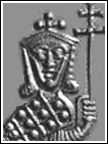
BASIL I, THE MACEDONIAN (867-886)
FOLLIS
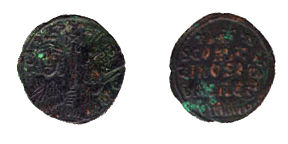
| Obv.: | Basil and Constantine VIII |
| Rev.: | 5-line legend: +bASILIO' / S CONStAn / tInOS En OEO / BASILEIS R / OmAIOn ("Basil and Constantine, by grace of God Kings of the Romans") |
| HISTORICAL NOTES: Founder of the great Macedonian dynasty, Basil enlarged the Empire both on its eastern and western frontiers. At home, he undertook the revision of Justinian's law books - a task to be completed later only by his son Leo the Wise. The missionary work by Cyrill and Methodius among South Slavs continued, resulting in the conversion of the Bulgarian king Boris (Michael) as well as Serbian tribes - acts which were to have far-reaching consequences for both the political and spiritual picture of the Balkan peninsula. |
NUMISMATIC NOTES: Byzantine bronze coins were often "recycled" by the mints, restriking earlier issues. The coin shown here was overstruck on one of Theophilos (829-842), with the earlier ruler's rotated bust partially showing through at the 2 o'clock position on the obverse. The reverse legend type, here specifically reading "Basil and Constantine, by the grace of God Kings of the Romans", will appear often for many centuries, and in translated form permeate later also to imperial Serbian coinage. |
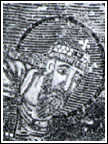
LEO VI, THE WISE (886-912)
FOLLIS
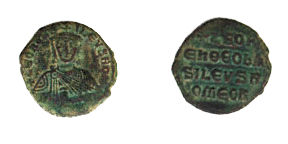
| Obv.: | Bust of Leo, legend: +LEOn bASILEVS RO' |
| Rev.: | 4-line legend: +LEOn En OEO bA / SILEVS R / OmEOn |
| HISTORICAL NOTES: A scholarly man, Leo completed the famous Basilica - an updated legal codex written in Greek. However, his military achievements were less remarkable, as enemies advanced in the Balkans, where the Bulgarians under Symeon proclaimed their First Empire, with a clear goal of replacing the Byzantine one. |
NUMISMATIC NOTES: The slow transition from a Roman to a Greek empire was linguistically reflected on coinage as well. As a continuation of Roman coinage and tradition, Byzantine money carried almost exclusively Latin inscriptions until the early 8th century, when Greek ones start to appear. However, these were usually written in a mixture of Greek and Latin letters - a phenomenon that persisted until sometime in the late 11th century, finally leaving purely Greek inscriptions. |
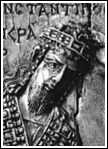
CONSTANTINE VII PORPHYROGENITOS (913-959)
FOLLIS
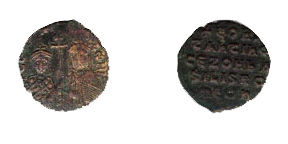
SILVER MILIARESION
| Obv.: | Busts of Constantine and Zoe holding patriarchal cross |
| Rev.: | 4-line legend: +CONST/ ANTINO' / CE ZOH BA / SILIS ROMEON |
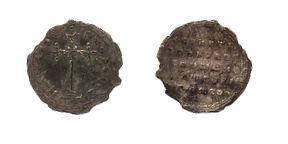
| Obv.: | Ornamented cross on three steps, legend: + IhSUS XRIStUS nICA ("May Jesus Christ conquer") |
| Rev.: | Rev.: 5-line legend: +CONST' T' / noRFVRoG' / CE ROMANO / En Xw EVSEb' / b' RWmEon ("Constantine Porphyrogenitos and Romanos, by the grace of Christ the pious Emperors of the Romans") |
| HISTORICAL NOTES: Constantine's work "On the Administration of the Empire" gave lasting advice on imperial foreign policy: "The enemy is to be neutralized through alliances with his opponents, pacified with gifts, drawn into the imperial sphere of influence, and finally annihilated". However, it is also an invaluable account of earlier South Slavic history and Balkan relations. During Constantine's reign the Serbian principality under Caslav ascended in the area of present-day Bosnia, Herzegovina, and Western Serbia - only to disintegrate after he died in battle against Hungarians (ca. 960). |
NUMISMATIC NOTES: Constantine's rule, which started when he was still a minor, was long and complex in terms of internal power struggles, as attested even by the personages on the coinage of this time - e.g., his co-emperor Romanus minting independent coinage. |
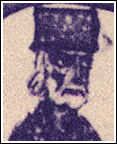
ROMANOS I LAKAPENOS (920-944)
FOLLIS
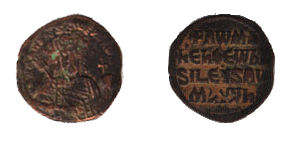
CAST BRONZE OF CHERSON
| Obv.: | Bust of Romanos with globe and scepter |
| Rev.: | Legend: + RWMA / n' En OEO bA / SILEVS RW / MAIOn |
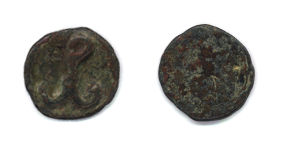
| Obv.: | Monogram ("Pw") of Romanos |
| Rev.: | Blank |
| HISTORICAL NOTES: A regent and later co-emperor of Constantine VII, Romanos was an able statesman, and de facto supreme ruler until deposed by court intrigue. He rose to the great challenge of defending the empire against the ambitious Bulgarian emperor Symeon - a task made easier after Symeon's death in 927. Romanos' support for Serbian Prince Caslav - in part to ensure further Bulgarian weakness - constituted an important element in the latter's rise. |
NUMISMATIC NOTES: After an absence from the Balkan interior for over three hundred years following the collapse of the Danube frontier before Slav and Avar incursions, monetary circulation starts to pick up again in these areas around the time of Romanos. For instance, excavations performed during the past three decades in the Belgrade fortress (ancient Singidunum) revealed a total of 67 Byzantine pieces, with Romanos' issues being the first after the late 6th c. coins of Maurice. Similar results are reflected in the finds around the eastern Serbian town of Pozarevac (ancient Viminacium). From the 9th-11th c., the mint of Cherson in the Crimea produced special cast (as opposed to struck) bronze coinage - of a design different than on bronzes from the regular mints, and of a denomination unknown. |
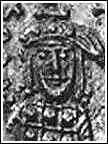
JOHN I TSIMISCHES (969-976)
SILVER MILIARESION
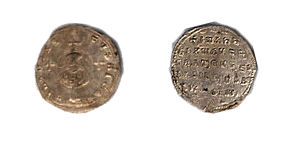
| Obv.: | Bust of the emperor in a circular medallion, legends: IWAnn; + IhSUS XRIStUS nICA |
| Rev.: | Rev.: 5-line legend: +IWAnn' / En XW AVtO / CRAT' EVSEb' / bASILEVS / RWmAIW' ("John, by the grace of Christ the Autocrator (Imperator) and pious King of the Romans") |
FOLLIS
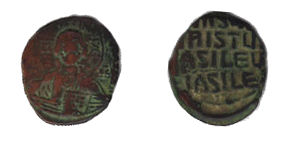
| Obv.: | Bust of Christ, legend: +EMMANOVH ("God is with us") |
| Rev.: | Rev.: 4-line legend: +IhSUS / XRISTuS / bASILEVS / bASILEI ("Jesus Christ, King of Kings") |
| HISTORICAL NOTES: Another able general, John took advantage of the turmoil in Bulgaria, pushing back Bulgarians and rebellious Serbs, as well as meddling Russians under Prince Svyatoslav. However, his premature death paved the way for the ascent of Macedonian Slavs under Samuilo, whose state would soon claim heritage to the otherwise mostly defunct First Bulgarian Empire. |
NUMISMATIC NOTES: More than a hundred years after the end of the iconoclast controversy, "anonymous" (i.e. without reference to issuing authority) bronze coinage with strictly religious images and messages is introduced - a practice that will last for about a hundred years to follow. Meanwhile - stylized, flat portraits gradually give way to more realism and beauty. |
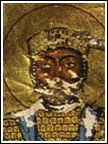
BASIL II BULGAROKTONOS (976-1025)
FOLLIS
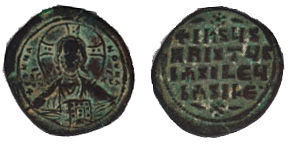
| Obv.: | Bust of Christ, legend: +EMMANOVH |
| Rev.: | Rev.: 4-line legend: +IhSuS / XRISTuS / bASILE / bASILE' |
FOLLIS
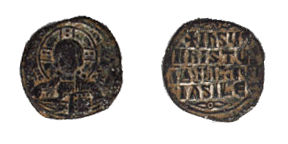
| Obv.: | Bust of Christ, legend: +EMMANOVH |
| Rev.: | Rev.: 4-line legend: +IhSuS / XRISTuS / bASILE / bASILE' |
| HISTORICAL NOTES: Pinnacle of the famed Macedonian dynasty, and in general of the Byzantine state after Justinian's times. Following a long campaign, Basil finally crushed Samuilo's army at Belasica in 1014 (thus his nickname "the Bulgar-slayer"), which led to the end of the First Bulgarian Empire four years later. Further to the North, Prince Vladimir of Kiev accepts Christianity, thus starting the important process of Russian conversion. Eventually, after the final 15th-c. the demise of Byzantium, a reasserted and expanding Russia will claim heritage to the Empire and a number of its institutions and roles. |
NUMISMATIC NOTES: The anonymous bronze coinage celebrating Jesus Christ as the King of kings ("King of those who rules"), takes off with a doubled weight standard, the activation of provincial mints, and vast coinage output. The peak was probably reached around the year 1000, with the total output for this type in the hundreds of millions. Some keys to the identity and production of mints may lie in the yet unresolved "secret-marks" (e.g., the various ornaments above and below the reverse inscription) - similarly to the case of later Serbian silver dinars. |
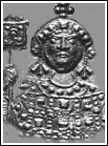
MICHAEL IV, THE PAPHLAGONIAN (1034-1041)
FOLLIS
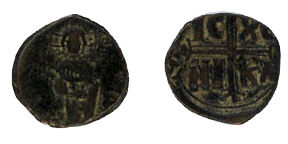
| Obv.: | Christ standing |
| Rev.: | Jeweled cross with inscription IC XC / NI KA ("May Jesus Christ conquer") |
| HISTORICAL NOTES: A capable ruler of poor health, Michael fought hard battles to subdue rebel Slavs in Macedonia and Serbia but died before a planned campaign against prince Stefan Vojislav, founder of the most significant 11th c. Serbian state, Zeta (around present-day Montenegro). |
NUMISMATIC NOTES: As limited as the monetary economy and circulation were during these times in the Balkans, it still could have a profound influence on political events. Michael's reversal of his predecessors' policies, and insistence on payment of certain taxes in cash rather than in kind, led to several Slavic revolts in the Balkans, including that of Prince Vojislav. To aggravate matters, the latter also appropriated a shipwrecked treasure of gold coins destined for the emperor - which, despite Michael's demands and punitive expeditions, was never to be returned. |
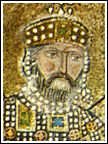
CONSTANTINE IX MONOMACHOS (1042-1055)
FOLLIS
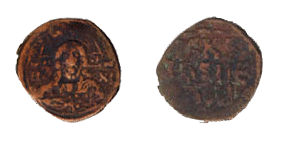
| Obv.: | Bust of Christ holding Book of Gospels with the left hand, the legend: IC XC |
| Rev.: | 3-line legend: IS XS / bASILE / bASILE' |
FOLLIS
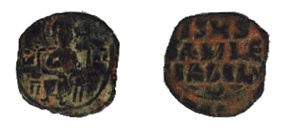
| Obv.: | Christ enthroned, holding Book of Gospels with left hand, legend: IC XC |
| Rev.: | 3-line legend: IS XS / bASILE / bASILE' |
| HISTORICAL NOTES: Constantine's reign saw progress in arts and letters, including the reopening of the University in Constantinople in 1045. The long-brewing schism of Eastern and Western churches formally occurred at the end of his reign, with profound effects to follow. A Russian attack on the capital was repelled, but a sizeable expedition to subdue prince Vojislav of Zeta (died 1051) in late 1042 failed, allowing for the latter's rise and expansion. |
NUMISMATIC NOTES: The image of Christ on a throne with a high back used in the second featured issue is the one that later became the standard rendition on Venetian silver grossi, as well as Serbian dinars. |
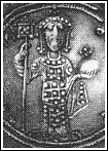
CONSTANTINE X DOUKAS (1059-1067)
FOLLIS
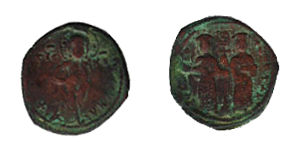
| Obv.: | Christ standing, legend: +EMMANOVH |
| Rev.: | Constantine and Evdokia holding labarum, Greek legend: +KWN T DK EVDK AVTO ("Constantine Doukas and Evdokia, Emperors") |
| HISTORICAL NOTES: A rather weak ruler influenced by his wife Evdokia (as evidenced by coinage as well) and others, Constantine came at a bad time for the Empire, with dangerous threats by the Normans in Italy, and Seljuks in Asia Minor. This might explain why in the Balkans he was on good terms with prince Vojislav's son, prince (later king) Mihailo of Zeta. |
NUMISMATIC NOTES: Although Constantine issued anonymous bronzes as well, the type featured here marks the first return of bronzes bearing the ruler's name after nearly a century. |
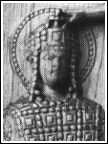
ROMANOS IV DIOGENES (1067-1071)
FOLLIS
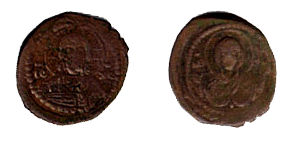
| Obv.: | Bust of Christ, legend: IC XC |
| Rev.: | Bust of Mother of God with arms spread, the legend: MP OV ("Mother of God") |
FOLLIS
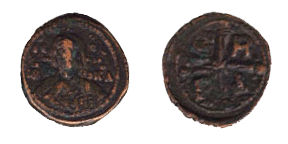
| Obv.: | Bust of Christ, legend: IC XC / NI KA |
| Rev.: | Cross with Greek letters C B P D (for "Lord help Romanos Diogenes") |
| HISTORICAL NOTES: Romanos' attempt to end the advance of Seljuk Turks in Asia Minor led to the devastating battle of Mantzikert (1071), where he was taken prisoner, and following which important parts of Asia Minor were forever lost. In the Balkans, his presence is still marked in the well-known St. George's church in Staro Nagoricino (near Kumanovo), which he built the original part of, later to be restored by the Serbian king Milutin. |
NUMISMATIC NOTES: The first, anonymous type featured here was only minted during Romanos' short reign and is unique in that it features Jesus Christ on one side, and Virgin Mary on the other. |
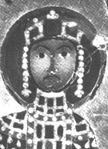
MICHAEL VII DOUKAS (1071-1078)
FOLLIS
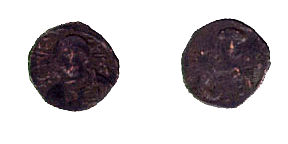
| Obv.: | Bust of Christ, legend: IC XC |
| Rev.: | Bust of Michael, Greek legend: +MIXAH BACI O D |
| HISTORICAL NOTES: Further losses - both to Normans in Italy, and particularly of the ancient Byzantine heartland of Asia Minor to the Seljuks - considerably weakened the state and later led to the Emperor's deposition. Still, his generals managed to tackle another uprising of Slavs in Macedonia, and partially defeat Mihailo of Zeta, who had acquired a royal title from the Pope in the meantime. |
NUMISMATIC NOTES: Documentary evidence shows that the Byzantine administration did much to promote a monetary economy in many areas of public life, starting with numerous kinds of taxes being payable in cash. Yet, this was still quite limited by modern standards, as price stability seems to have persisted for a long time until around 1075 when Michael's money debasements and other economic flops caused visible inflation to appear. This earned him the derogatory nickname "Parapinakes" - "less a quarter" - indicating that money now bought a quarter less of the usual batch of grain. |
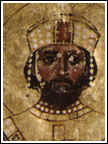
NIKEPHOROS III BOTANIATES (1078-1081)
FOLLIS
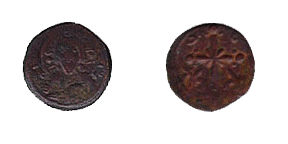
| Obv.: | Bust of Christ, legend: IC XC |
| Rev.: | Latin cross with crescents and Lillies |
| HISTORICAL NOTES: The inability of the feeble emperor Michael Doukas to face mounting external and economic threats prompted the rise of the elderly general Nikephoros. However, this ended being a brief reign marked by continuous power struggles, finally ending with the ascension of another member of the military aristocracy - the young but powerful Alexios Komnenos. Having retired to a monastery, Nikephoros was thus one of the few Byzantine (or Roman in general) emperors to peacefully relinquish the throne. |
NUMISMATIC NOTES: The delicate balance between nominal and intrinsic values for gold (and other precious metal) coinage was always among the keys to monetary stability. The apparent mid-11th c. rise of gold prices threatened this, as it promoted hoarding gold out of circulation. Nikephoros' radical response was to halve the intrinsic value (pure gold content) of the gold nomisma down to about 8 carats fine. But this only further sent the economy into a tailspin, and it was not until Alexios' monetary reform several years later that the state's fiscal situation started to stabilize. |
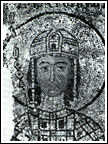
ALEXIOS I KOMNENOS (1081-1118)
TETARTERON NOMISMA
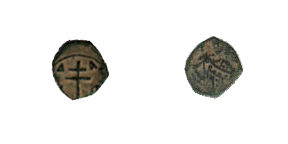
| Obv.: | Patriarchal cross, Greek letters alpha and lambda |
| Rev.: | Bust of Alexios |
| HISTORICAL NOTES: Founder of the well-known Komneni dynasty. Alexios repelled a strong Norman threat with the help of Venetians, whom he then granted extensive trading privileges (1082) - a move that would later hurt the economic sovereignty and eventually viability of the state. Serbs around Bodin, the new king of Zeta, first benefited from the ensuing war between Byzantium and the First Crusaders, but were later marred by bloody power struggles which allowed Alexios, late in his reign, to reduce them again to vassal status. |
NUMISMATIC NOTES: Author of a great monetary reform (1092), which restored the quality of debased money. It produced the gold hyperpyron and other lesser denominations in different metal alloys, featuring cup-shaped (scyphate) coins, known as trachy. The exception to this rule was the small, flat bronze tetartera shown here, and their relationship to the larger denominations remains uncertain. |
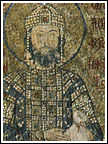
JOHN II KOMNENOS (1118-1143)
TETARTERON
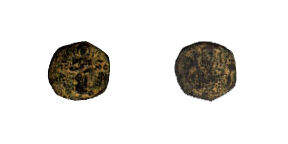
BILLON TRACHY
| Obv.: | Christ standing, legend: IC XC |
| Rev.: | Bust of John |
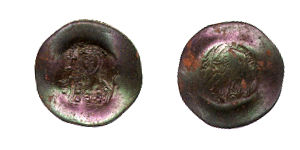
| Obv.: | Bust of John |
| Rev.: | Bust of Christ, legend: IC XC |
| HISTORICAL NOTES: A capable ruler who largely continued his father's policies. He retained overlordship over Serbs by suppressing an uprising, but they soon became an increasingly important factor in the intricate relationship between Byzantium and the emerging regional power Hungary. |
NUMISMATIC NOTES: While the tetarteron nomisma shown here was a coin of rather low significance given the documented elaborate system of higher denominations, it draws its name from a lighter-weight gold coin of the same thick, flat fabric that existed in the period 963 - 1092. |
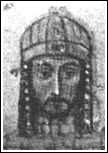
MANUEL I KOMNENOS (1143-1180)
BILLON TRACHY
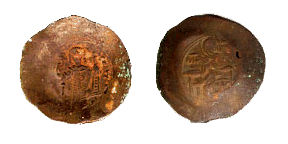
| Obv.: | Manuel standing, with globe and labarum |
| Rev.: | Mother of God, legend: MP OV |
BILLON TRACHY
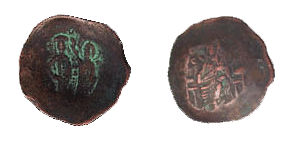
| Obv.: | Mother of God crowning Manuel |
| Rev.: | Christ enthroned |
TETARTERON
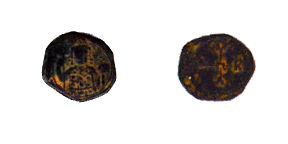
| Obv.: | Facing bust of Manuel |
| Rev.: | Monogram of Manuel |
| HISTORICAL NOTES: More a warrior than a statesman, but for many, Manuel was the last great Byzantine emperor. Interspersed with his struggles with Normans and Venetians in the Adriatic and particularly with the Hungarians in the Balkans were his changing relationships with Serbian grand zupans (princes) in the heartland of Raska (Rascia) - first with Uros and Desa, and later with the founder of firm Serbian statehood, Stefan Nemanja. The latter's spectacular surrender to Manuel in 1172 at first appeared humiliating, yet allowed Raska to prosper as an autonomously ruled Byzantine principality. |
NUMISMATIC NOTES: The cup-shaped coins (trachy) shown were made out of billon, an alloy of copper and silver. The silver content started at around 6%, but inflationary pressures later dropped to under 2%. |
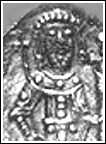
ISAAC II ANGELOS (1185-1195)
BILLON TRACHY
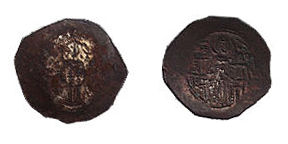
| Obv.: | Isaac standing |
| Rev.: | Mother of God enthroned with a medallion of infant Christ, legend: MP OV |
| HISTORICAL NOTES: Isaac's main problems were in the Balkans, with trouble from forces of the Third Crusade, and the sudden emergence of the Second Bulgarian Empire. Also, Nemanja's well-documented conquests - which had started just prior to Isaac's elevation to the throne - considerably enlarged the Serbian state in the East and Southern Adriatic regions. Isaac's victory over the Serbs in 1190 checked further advances but left most acquisitions intact, sealed by a court marriage. |
NUMISMATIC NOTES: Political and economic woes early in Isaac's reign precipitated an obvious debasement of the currency, notably with the billon trachy. Neatly clipped, reduced-weight, and/or reduced-silver pieces start becoming the norm, although the issue featured here appears still to be of the original standard, given the size and the silverlike appearance of part of the obverse center. |
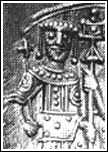
ALEXIOS III KOMNENOS-ANGELOS (1195-1203)
BILLON TRACHY
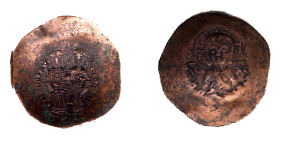
"BULGARIAN IMITATIVE" BILLON TRACHY
| Obv.: | Alexios standing with St. Constantine |
| Rev.: | Bust of beardless Christ, Greek legends: + KE BOHOEI ("Lord help") and IC XC |
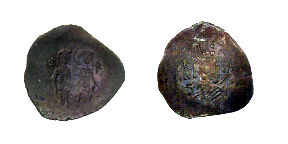
| Obv.: | Emperor standing with St. Constantine |
| Rev.: | Bust of beardless Christ, Greek legends: + KE BOHOEI ("Lord help") and IC XC |
| HISTORICAL NOTES: During Alexios' tenure, Serbia spins out on a completely independent path, with Alexios' son-in-law Stefan Prvovencani (The First-Crowned) guiding the state, and the latter's brother St. Sava (Sabbas) the church. Alexios' woes were compounded by the further rise of the Bulgarian empire, as well as serious threats from the German emperor Henry VI and Pope Innocent III. But in the end, it was the forces of the Fourth Crusade, directed by Venice, that captured Constantinople and set the stage for the Latin occupation that would last for several decades. |
NUMISMATIC NOTES: The troubled reign of Alexios saw a steady rise in monetary anarchy, including the appearance of so-called "Bulgarian imitations" - a special class of reduced-weight trachea. Many conjectures this to actually be expediency imperial issues since they are found in hoards well beyond the realm of the fledgling Second Bulgarian Empire. Constantine the Great appears again after over 850 years on Byzantine coinage, here as the saintly figure patronizing the current Emperor. |
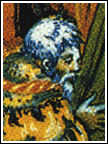
LATIN OCCUPATION OF CONSTANTINOPLE AND THESSALONIKI (1204-1261)
BILLON TRACHY OF THESSALONIKI (1204-1230)
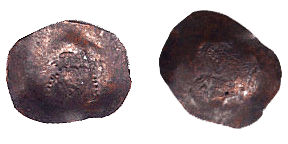
| Obv.: | Emperor standing |
| Rev.: | Bust of Christ |
| HISTORICAL NOTES: Western knights and their puppet emperors (starting with Baldwin of Flanders, pictured) never managed to establish a viable state in Byzantium. It was ended by Michael VIII Palaiologos, Emperor of Nicaea (Asia Minor), where much of the Byzantine nobility fled after the sack of its capital. In the words of one of the preeminent modern historians of the Empire, Lord Norwich, "by Constantinople's sack, Western civilization suffered a loss greater than the sack of Rome by the barbarians in the fifth century or the burning of the library of Alexandria by the soldiers of the Prophet in the seventh - perhaps the most catastrophic single loss in all history." |
NUMISMATIC NOTES: Coins struck during this time were imitations, often careless ones, of earlier Byzantine issues. This one features an obverse (with the exaggerated jewels on the emperor's cloak) from an Alexios I coin, the reverse with the image of a beardless Christ apparently taken from a later issue of Manuel I. |
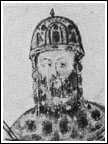
MICHAEL VIII PALAIOLOGOS (1258 - 1282)
GOLD HYPERPYRON
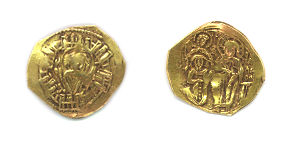
CLIPPED COPPER TRACHY
| Obv.: | Facing the bust of Mother of God, surrounded by a circular representation of the walls of Constantinople |
| Rev.: | Standing Christ blessing kneeling emperor, assisted by Archangel Michael, Greek legend: PALEOLOGOU |
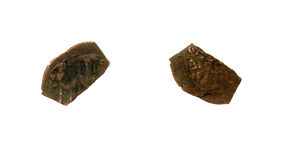
| Obv.: | Michael standing, holding labarum, Greek legend: DESPOTI |
| Rev.: | Standing figure of St. Demetrius, Greek legend: O AGIOS DEMETRIOS |
| HISTORICAL NOTES: "If we have just retaken the city in spite of the resistance of its defenders... it is only as a result of the Divine Power which enfeebles those that appear most invincible..." - declared the founder of the final Byzantine dynasty to his subjects, upon liberating their capital from the Latins on 1261. An astute statesman and quintessential Byzantine politician, Michael staved off numerous threats, but at a cost to the Empire's viability that was soon to be felt. During his reign, he dealt with three successive Serbian monarchs (Uros, Dragutin, and Milutin), in varying capacities. Despite successes against hostile Western powers, he was unable to reverse king Milutin's permanent expansion into Macedonia, as he suddenly died assembling a punitive expedition. |
NUMISMATIC NOTES: Michael's ambitious undertakings could not be adequately supported by a weakened economy and state treasury. Gold hyperpyra were still issued and certainly used - e.g., to help "fund" the famous Sicilian Vespers, where a popular uprising eliminated the growing French threat. But visible gold debasement started to take place, and bronze coinage - especially the scyphate type like the severely mutilated piece shown here - was quickly losing importance. |
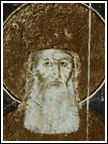
ANDRONIKOS II PALAIOLOGOS (1282-1328)
DEBASED GOLD HYPERPYRON
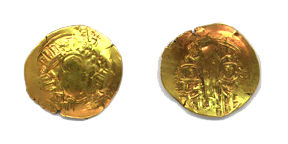
| Obv.: | Facing the bust of Mother of God, surrounded by a circular representation of the walls of Constantinople |
| Rev.: | Standing Christ blessing kneeling emperor and co-emperor Michael IX |
| HISTORICAL NOTES: Andronikos' long rule is concurrent and closely tied with that of King Milutin, his latter-day son-in-law. Their early adversarial relationship gave way to an alliance, sealed by court marriage, in 1299. Often perceived as a Byzantine weakness, this move perhaps also exemplifies the calculated political pragmatism that characterized the Constantinopolitan court's foreign relations for a millennium. However, a mere couple of decades after Andronikos was forced to a monastery following a civil war with his grandson, such policies brought to the European scene another player - the Ottoman Turks - whose eventual impact was vastly to surpass the role of a civil war bargaining chip originally intended for them. |
NUMISMATIC NOTES: The political and economic decline of the state is also reflected in its currency. On the one hand, silver coinage based on the Venetian standard here called the basilikon, had to be introduced around 1300. On the other, the gold hyperpyron was severely debased - by now only 12 carats fine - and soon to disappear. However, its obverse features a design element introduced not long before: surrounding a facing image of the Virgin - the city protectress and patron - are shown the walls of Constantinople. The massive 5th c. structure was a symbolic, but often also a factual pillar of the Empire's stability; a century and a half later (May 29, 1453), it was finally to be breached for good by Mehmet the Conqueror's Ottoman armada. |
Others
More Information
BLAGO Content
While the content of the BLAGO Fund collections is free to use, there are also some restrictions on commercial use and proper attribution of the material. Follow the links below for more information.
> BLAGO Collections License
> Image Request
BLAGO Fund also accepts the contribution of material. Please contact us with any material you wish to publish on our website.
Contact
BLAGO Fund, Inc.
PO Box 60524
Palo Alto, CA 94306
USA
info@blagofund.org

